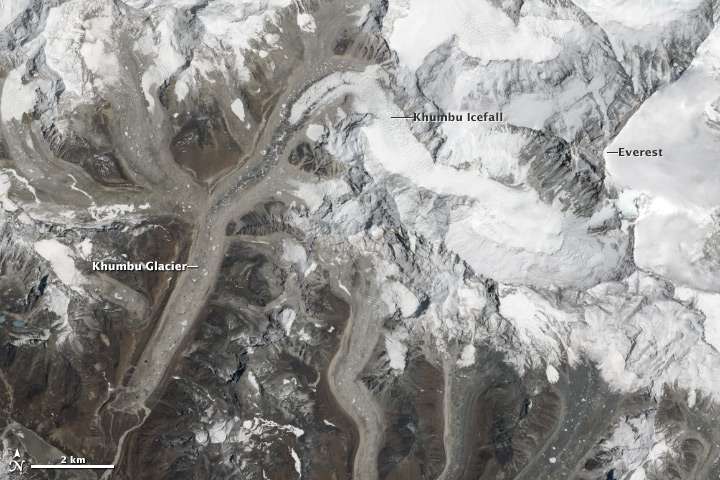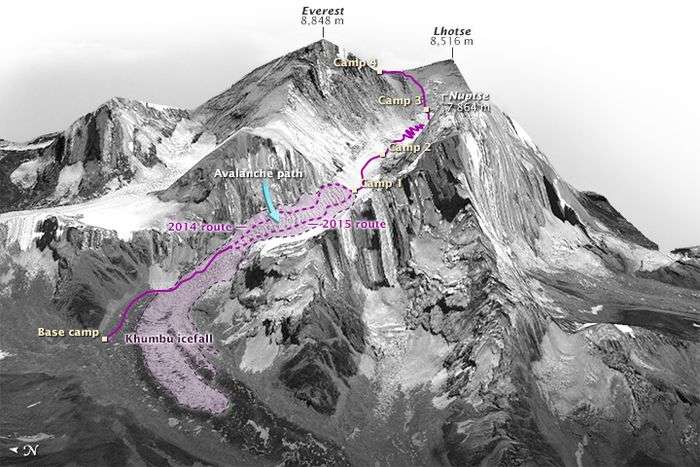Khumbu Icefall


The Khumbu Icefall is an icefall located at the head of the Khumbu Glacier and the foot of the Western Cwm, which lies at an altitude of 5,486 metres (17,999 ft) on the Nepali slopes of Mount Everest, not far above Base Camp and southwest of the summit. The icefall is considered one of the most dangerous stages of the South Col route to Everest's summit.[1]
Overview
The Khumbu glacier that forms the icefall moves at such speed that large crevasses open with little warning, and the large towers of ice (called seracs) found at the icefall have been known to collapse suddenly. Huge blocks of ice tumble down the glacier from time to time, their size ranging from that of cars to large houses. It is estimated that the glacier advances 0.9 to 1.2 m (3 to 4 ft) down the mountain every day.
Most climbers try to cross the icefall during the very early morning, before sunrise, when it has partially frozen during the night and is less susceptible to movement. As the intense sunlight warms the area, the friction between the ice structure lessens and increases the chances of crevasses opening or blocks falling. The most dangerous time to cross the Khumbu Icefall is generally mid- to late-afternoon. Strong, acclimatized climbers can ascend the icefall in a few hours, while climbers going through it for the first time, or lacking acclimatization or experience, tend to make the journey in 10–12 hours. "Camp I" on Everest's South Col route is typically slightly beyond the top of the Khumbu Icefall.
On occasion, a climber will experience a large block of ice crashing down in their vicinity. The resulting blast of displaced air and snow can result in a "dusting" (the depositing of a billowing cloud of light ice and snow on the climber). To those that have experienced it, it is a very unnerving experience. If a climber is caught in an avalanche or other "movement" event in the icefall, there is very little they can do except prepare for potential entrapment by heavy blocks of ice or immediate movement afterwards, to try to rescue others. It is virtually impossible to run away or even to know which way to run.
Since the structures are continually changing, crossing the Khumbu Icefall is extremely dangerous. Even extensive rope and ladder crossings cannot prevent loss of life. Many people have died in this area, such as a climber who was crushed by a 12-story block of solid ice. Exposed crevasses may be easy to avoid, but some may be hidden under dangerous snow bridges, through which unwary climbers can fall.

2014 avalanche
Around 6:30 am local time, on the morning of 18 April 2014, 16 Nepalese climbers were killed by an avalanche in the Khumbu Icefall.[2] As of 22 April, 13 bodies had been recovered, and three remained missing, presumed dead.[3] The climbers were preparing the route through the dangerous icefall for the spring climbing season when the avalanche engulfed them.[4] Nine others sustained blunt trauma injuries.[3]

References
- ↑ UNITEC Institute of Technology. "Hillary Challenge". Ministry of Education, Wellington, New Zealand. Retrieved 2009-01-30.
- ↑ "Mount Everest avalanche kills 12 Nepalese guides". CBC News. 18 April 2014. Retrieved 2014-03-18.
- 1 2 Krakauer, Jon (21 April 2014). "Death and Anger on Everest". The New Yorker. Retrieved 22 April 2014.
Of the twenty-five men hit by the falling ice, sixteen were killed, all of them Nepalis working for guided climbing teams.
- ↑ Burke, Jason; Rauniyar, Ishwar (18 April 2014). "Mount Everest avalanche leaves at least 12 Nepalese climbers dead". The Guardian. Retrieved 2014-03-18.
External links
| Wikimedia Commons has media related to Khumbu Icefall. |
Coordinates: 27°59′45″N 86°52′22″E / 27.99583°N 86.87278°E
